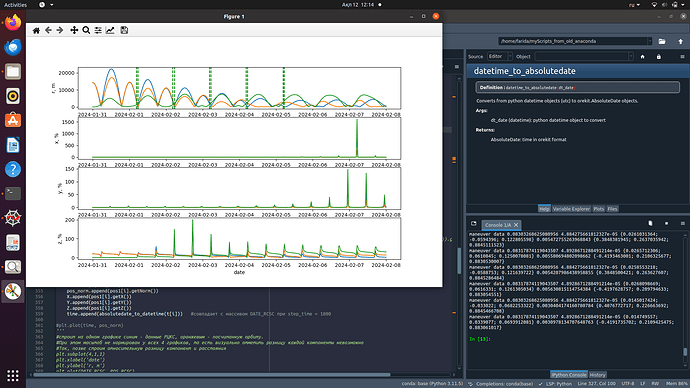Hello!!
maneuverStartDate = maneuverStartDates[0]
maneuverStopDate = maneuverStopDates[-1]
generator = propagator_num.getEphemerisGenerator()
propagator_num.propagate(maneuverStartDate, maneuverStopDate)
ephemeris = generator.getGeneratedEphemeris()
lvlh = LocalOrbitalFrame(FramesFactory.getGCRF(), LOFType.LVLH, ephemeris, 'LVLH')
#LVLH X axis aligned with position, Z axis aligned with orbital momentum
#GCRF The X-axis is aligned with the mean equinox of Earth at 12:00 Terrestrial Time on the 1st of January, 2000, and the Z-axis is aligned with the Earth´s rotation axis.
propagator_num = NumericalPropagator(integrator)
for i in range(len(maneuverStartDates)):
maneuverStartDate = maneuverStartDates[i]
maneuverDuration = maneuverDurations[i]
maneuverStopDate = maneuverStopDates[i]
delta_Ax = delta_Axs[i]
delta_Ay = delta_Ays[i]
delta_Az = delta_Azs[i]
delta_Vx = delta_Ax*maneuverDuration
delta_Vy = delta_Ay*maneuverDuration
delta_Vz = delta_Az*maneuverDuration
delta_V_abs = (delta_Vx**2+delta_Vy**2+delta_Vz**2)**0.5
delta_A = (delta_Ax**2+delta_Ay**2+delta_Az**2)**0.5
delta_V = Vector3D(float(delta_Vx), float(delta_Vy), float(delta_Vz))
#the acceleration direction in satellite frame.
delta_V_lvlh = inertialFrame.getStaticTransformTo(lvlh, maneuverStartDate).transformVector(delta_V)
specificImpulse = 4400.0 #sec (depends on type of propellant used for maneuver) #ion propulsion #efficiency
delta_m = -1700*(1-np.exp(delta_V_abs/specificImpulse/9.80665)) #g0 = 9.80665 - sea level standard acceleration of gravity
thrustForce = delta_A*1700.0
maneuverDirection = Vector3D(float(delta_V_lvlh.getX()/delta_V_abs), float(delta_V_lvlh.getY()/delta_V_abs), float(delta_V_lvlh.getZ()/delta_V_abs))
print('maneuver data', thrustForce, delta_A, delta_V, delta_m, maneuverDirection)
propagator_num.addForceModel(ConstantThrustManeuver(maneuverStartDate, float(maneuverDuration),
float(thrustForce), float(specificImpulse), maneuverDirection))
step_time = 1800
duration = 86400 * 6.0 + step_time
propagator_num.setOrbitType(OrbitType.CARTESIAN)
propagator_num.setInitialState(initialState)
propagator_num.addForceModel(HolmesFeatherstoneAttractionModel(ITRF, gravityProvider))
propagator_num.addForceModel(ThirdBodyAttraction(CelestialBodyFactory.getSun()))
propagator_num.addForceModel(ThirdBodyAttraction(CelestialBodyFactory.getMoon()))
propagator_num.addForceModel(SolarRadiationPressure(sun, earth, isotropicRadiationSingleCoeff))
t = [initialDate.shiftedBy(float(dt)) \
for dt in np.arange(0, duration, step_time)]
pos1 = [propagator_num.propagate(tt).getPVCoordinates().getPosition() for tt in t]
vel1 = [propagator_num.propagate(tt).getPVCoordinates().getVelocity() for tt in t]
I have input data for maneuvers in GCRF frame, so i need to translate it to spacecraft frame (Do i need to use specific one??). To do so, it’s necessary to use getEphemerisGenerator() and propagate the orbit. I wanted to know do I have to create new propagator and add all of the disturbances again, i.e. to make it twice (the first propagator without including maneuvers and second one with maneuvers)??
